Abstract
Addressing the challenges posed by Saline-Alkali land holds significant promise for optimizing agricultural resources and fostering sustainable agricultural development in affected areas. This study explores the efficacy of coal-based solid waste soil conditioner and vermicompost as mixed-component soil amendments in varying proportions. Through comprehensive field experiments, we investigate the impact of these amendments on soil physicochemical properties, microbial diversity, and the growth of L. chinensis, a grass species native to saline areas. Our findings reveal that the application of vermicompost-based soil amendments effectively reduced soil conductivity and led to noteworthy improvements in the pH of Saline-Alkali soil. Moreover, these amendments demonstrated a marked capacity to enhance soil organic matter and available nutrients, most notably available phosphorus. Concurrently, the introduced soil amendments exhibited a positive influence on soil microbial diversity. A correlation analysis underscores the pivotal roles of soil pH and organic matter in shifting soil microbial communities. In response to amendments, L. chinensis exhibited varying degrees of growth enhancement, with biomass increments ranging from 6.37% to 19.91%. In summary, vermicompost and soil conditioner can improve Saline-Alkali land by supplementing organic matter and effective nutrients, improving pH and conductivity, and regulating microbial community, so as to realize the restoration and improvement of Saline-Alkali land; the greatest improvement was achieved with soil conditioner and vermicompost application rates of 30,000 kg·ha−1 and 15,000 kg·ha−1, respectively. Our results provide robust support for advocating for the integration of vermicompost-based soil amendments in Saline-Alkali land management strategies.
1. Introduction
Saline-Alkali soil, widely distributed on Earth [1,2], constitutes a significant concern due to its adverse impact on global food security and ecosystem functionality. Particularly, the expensive extent of Saline-Alkali land in China, covering an area of 900 million ha [3], underscores the gravity of the issue. Salinization-induced hydraulic potential reduction curtails plant water absorption, subsequently impeding nutrient uptake. Concurrently, salt accumulation within plants can potentially induce toxicity, disrupting cell metabolism, retarding growth, and ultimately diminishing crop yields [4,5,6]. Notably, the profound consequences of soil salinization have rendered vast tracts of land unsuitable for cultivation, emerging as a pivotal constraint on agricultural productivity [7].
Previous studies have shown that the incorporation of coal-based solid waste as a soil conditioner in Saline-Alkali land can improve the soil’s physical properties. However, its effectiveness is greatly restricted due to the low nutrient content and microbial diversity of the soil amendment itself [8,9,10,11]. Vermicompost represents the feces excreted by worms after they consume organic matter, which passes through their specialized digestive system, and vermicompost is rich in both nutrients and microorganisms [12,13]. For example, Yuan et al. and other scholars [14,15] believe that applying worm waste as an amendment to Saline-Alkali soil can effectively increase the nutrient content of the soil and, to some extent, improve its fertility. Lu et al. [16,17,18] reported that some elements in soil amendments can bind to harmful ions in the soil, reducing their impact on plants. Bai et al. [19,20] found that combining soil conditioner and organic fertilizer could reduce the soil pH and available salt concentration; significantly improve organic matter and nutrient concentrations; increase soil enzyme activities; significantly enhance root vigor and rhizosphere soil microbial activity; and significantly increase the total root length, root surface area, and root volume. These changes promote the formation of a plant–soil–microbial symbiotic system. Because both vermicompost and soil amendments have excellent physical and chemical properties, the combination of vermicompost and soil amendments may have a certain role in improving alkali soil. However, there have been few studies on the effect of vermicompost combined with other soil amendments on improving sandy Saline-Alkali soil and characterizing their impact on microbial diversity.
This current study aimed to investigate the effects of vermicompost and a coal-based soil conditioner as amendments on the physicochemical properties, microbial community structure of the soil, and plant growth in Saline-Alkali soil, using L. chinensis as the indicator species and a field plot experimental method. This study provides a theoretical basis for the application of vermicompost-based mixed amendments to sandy Saline-Alkali land.
We hypothesized that (1) applying coal-based solid waste and vermicompost as an amendment to Saline-Alkali soil can effectively increase the physicochemical properties of the soil. (2) Applying coal-based solid waste and vermicompost can effectively improve the physiological and biochemical indexes of plants. (3) The microbial diversity would also be changed by soil amendments in Saline-Alkaline soils.
2. Materials and Methods
2.1. Experimental Materials
The experimental site is located at Qidun Village, Huangsha Town, Yulin City, Shaanxi Province, Northwest China (109°32′52″ E, 38°12′22″ N) (Figure 1), with an altitude of 1125 m, an average annual temperature of 10.1 °C, an annual frost-free period of 151 days, and an annual rainfall of 427.5 mm. The soil was classified as Salic Fluvisol (Word Reference Base for Soil Resources, WRB system). The texture was sandy loam containing 21.1% of sand, 61.7% of silt, and 17.2% clay. The soil of the experimental site was medium Saline-Alkali, with a total salt content of 1.9 g·kg−1 in the top 20 cm of soil and belonging to the soil classification of moderate Saline-Alkalization, the groundwater level in the salt return period was only 30–40 cm, and the average groundwater level in the salt spraying period was 1.5 m [3]. Seeds of the grass L. chinensis were purchased from a local agricultural company, the development and utilization of coal will produce a large amount of coal-based solid waste, which has excellent physical properties. The vermicompost was purchased from a fertilizer company in Yulin (China); domestic sludge and cow manure were the main components, and the solid waste soil conditioner based on the coal was independently developed by the research team The contents of heavy metals in vermicompost and soil conditioner were lower than the national standard. The basic characteristics of Saline-Alkali soil at 0–20 cm depth, as well as the soil conditioner and vermicompost, are shown in Table 1.
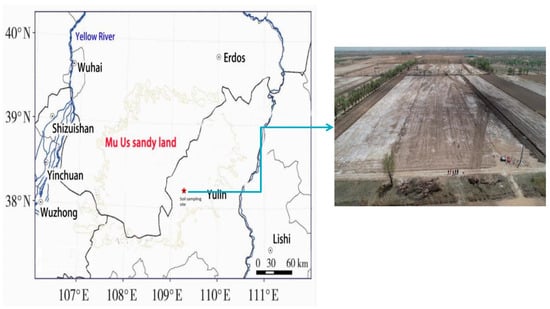
Figure 1.
Location of the test area.

Table 1.
Composition of Saline-Alkali soil, soil conditioner, and vermicompost.
2.2. Experimental Design
The experiment used a randomized block design with three biological replicates of each of the four treatments: control, SC-T1, SC-T2, and SC-T3. The control represented no soil amendment, whereas the treatment groups received different application rates of the combined amendment made up of soil conditioner and vermicompost. The application rates for SC-T1 were 30,000 kg·ha−1 for soil conditioner and 15,000 kg·ha−1 for vermicompost; for SC-T2, the rates were 22,500 kg·ha−1 for both soil conditioner and vermicompost, whereas, for SC-T3, the rates were 15,000 kg·ha−1 for soil conditioner and 30,000 kg·ha−1 for vermicompost [21]. All of the amendments were applied at the same time. The weights of soil conditioner and vermicompost were evenly mixed and spread onto the corresponding plots. After application, the soil was tilled and leveled with a rotary cultivator to a depth of 20 cm. Each plot size was 3 m × 3 m (Figure 2), and the sowing rate of L. chinensis seeds was 6.0 g·m−2. The seeds were sown by strip seeding at a depth of 1 cm with an inter-row spacing of 25 cm. Drip irrigation was used to water the plots using drip irrigation with an irrigation volume of 20 m3/hm, and regular manual weeding was conducted. No other fertilizer was applied to the plots. The experimental plots were set up on 23 May 2021, and the soil and plant samples were taken on 10 September 2022.
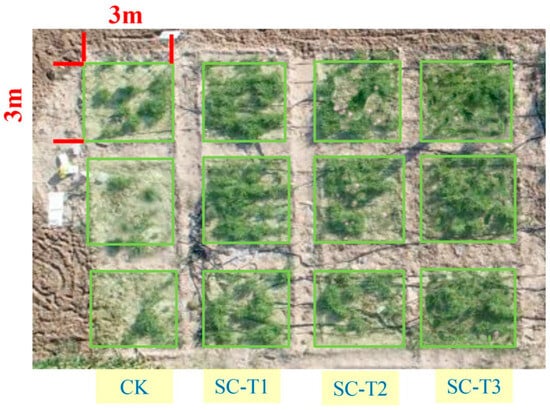
Figure 2.
Saline-Alkali improvement test sites.
2.3. Soil Physicochemical Properties
Soil moisture was determined by the oven-drying method (105 °C, 24 h). Soil porosity was determined using the cylinder (volume is 100 cm3). The pH(1:2.5) was determined using a calibrated pH meter (PHSJ-4F, Leici, Shanghai, China). The Electrical Conductance (EC) was determined using a conductivity meter (DDSJ-318T, Leici, Shanghai, China). Soil organic matter (SOM) concentration was determined using the K2Cr2O7 colorimetric oxidization [22]. The available potassium (AK) concentration was determined by ammonium acetate solution extraction [23]. The available phosphorus (AP) concentration was determined using the Olsen method [24]. The alkaline hydrolyzable nitrogen (AN) concentration was determined using the alkali diffusion method [25]. The catalase (CAT) activity was determined by potassium permanganate colorimetric titration [26]. The sucrase (SUC) activity was determined using the 3,5-dinitrosalicylic acid colorimetric method [27]. The alkaline phosphatase (ALP) activity was determined using the phosphobenzenedisodium (4-aminoantipyrine) colorimetric method [28], whereas the polyphenol oxidase (PPO) activity was determined using the colorimetric method [29].
2.4. Plant Traits
Five L. chinensis plants were collected at random from each plot. The plant height and leaf area were measured using a ruler [30], whereas the stem diameter was measured using vernier calipers. The collected L. chinensis plants were killed (80 °C, 24 h) and then placed in an oven to dry for 24 h to a constant weight to obtain the dry weight. The superoxide dismutase (SOD) activity was determined using the pyrogallol autoxidation method [31], whereas the peroxidase (POD) activity was determined using the benzidine test [32]. Malondialdehyde (MDA) concentration (a measure of lipid peroxidation, acting as an indicator of oxidative stress) was determined using the thiobarbituric acid method [33].
2.5. Soil Microbial Communities
Soil DNA was extracted using the OMEGA Soil DNA Kit (D5625-01; Omega Bio-Tek, Norcross, GA, USA), and DNA concentration and purity was measured using the NanoDrop 2000 spectrophotometer. Next, we amplified the V3-V4 hypervariable region of the bacterial 16S rRNA gene using primers 338F (5′-barcode+ACTCCTACGGGAGGCAGCA-3′) and 806R (5′-GGACTACHVGGGTWTCTAAT-3′). Afterward, we combined PCR products from the same sample in equal proportions and controlled for successful amplification and relative band intensity, using 2% agarose gel electrophoresis. To quantify the PCR product, we used the Quant-iT PicoGreen dsDNA Assay Kit, following the manufacturer’s instructions, on a microplate reader from BioTek, FLx800. Finally, we sequenced the samples using the NovaSeq6000 SP Reagent Kit (500 cycles) on an Illumina NovaSeq system for 2 × 250-bp paired-end sequencing [34].
2.6. Data Analysis
We analyzed the data using single-factor analysis of variance (one-way ANOVA) in SPSS 23.0 software (IBM, Armonk, NY, USA) to test for significant differences, and we subsequently performed multiple comparison analysis to identify significant differences among treatments. Pearson’s correlation coefficient was used to reveal the relationships among variables. The results of the quantitative analysis are reported as mean ± standard deviation (SD), and the level of significance was set to p < 0.05. The CANOCO 5.0 was used to perform a redundancy analysis (RDA) [35], and the TB tool was used to create heat maps. A comprehensive evaluation of the alkali soil improvement effect of vermicompost mixed with soil conditioner with different ratios was performed using membership function [36].
The formula for calculating the membership function is as follows:
R (Xi) = (Xi − Xmin)/(Xmax − Xmin)
Calculation formula of inverse membership function value:
where Xi is the measured value of the index, and Xmax and Xmin are the maximum and minimum values, respectively, of a certain index of all of the tested materials.
R’ (Xi) = 1 − (Xi − Xmin)/(Xmax − Xmin)
3. Results
3.1. Growth and Oxidative Stress Tolerance of L. chinensis
Through the application of vermicompost combined with soil conditioner to improve Saline-Alkali soil, it can effectively improve the physiological and biochemical indexes of L. chinensis. Among them, SC-T3 treatment had the best lifting effect (Figure 3). Compared with the control, the leaf area, biomass, and diameter of different treatments were increased, and the leaf area and diameter reached a significant difference level (p < 0.05). Compared with the control, the leaf area and diameter of SC-T1, SC-T2, and SC-T3 were increased by 0.83%, 23.12%, and 48.14%, and 14.10%, 18.59%, and 30.13%, respectively (Figure 3a,d). The stress resistance index of L. chinensis could be effectively improved by improving the Saline-Alkali soil (Figure 3). Compared with the control, the catalase activity of L. chinensis decreased significantly (Figure 3e), while the activities of POD and SOD increased to a certain extent and reached a significant difference level. Among them, the activity of superoxide dismutase increased with the increase in application amount of vermicompost. The superoxide dismutase activity of SC-T1, SC-T2, and SC-T3 was increased by 170.4%, 188.6%, and 216.6%, respectively (Figure 3g,h).

Figure 3.
Effects of different treatments on the growth of L. chinensis. Lowercase letters indicate whether the samples of the same index are significantly different from each other (p < 0.05). Note: CAT—catalase; MDA—malondialdehyde; POD—peroxidase; SOD—superoxide dismutase. (a) Leaf area of L. chinensis; (b) Biomass of L. chinensis; (c) Plant height of L. chinensis; (d) Stem diameter of L. chinensis; (e) Catalase activity of L. chinensis; (f) Malondialdehyde enzyme activity of L. chinensis; (g) Peroxidase activity of L. chinensis; (h) Superoxide dismutase activity of L. chinensis.
Membership function formula was used to calculate the membership values of the leaf area, biomass, plant height, diameter, CAT, POD, and SOD under different treatments, and the membership values of MDA were calculated by inverse membership function (Figure 4). The larger the value, the better the improvement of vegetation indexes, and the comprehensive scores of different treatments were all greater than the control, among which SC-T3 scored the highest, with 4.76.

Figure 4.
Comprehensive score of vegetation. Lowercase letters indicate whether the samples of the same index are significantly different from each other (p < 0.05).
3.2. Effects of Soil Amendments on the Versatility of Saline-Alkali Soils
In general, the application of vermicompost combined with soil conditioner to improve Saline-Alkali soil can effectively improve the versatility of Saline-Alkali soil (Figure 5). Compared with the control, vermicompost combined with soil conditioner could effectively improve the physical and chemical properties of Saline-Alkali soil, and soil organic matter, soil available phosphorus, and available potassium reached significant difference levels (p < 0.05). Compared with CK, the soil organic matter and available phosphorus in SC-T1, SC-T2, and SC-T3 increased by 39.67%, 32.71%, and 17.83%, and 28.73%, 63.02%, and 59.81%, respectively (Figure 5e,f).
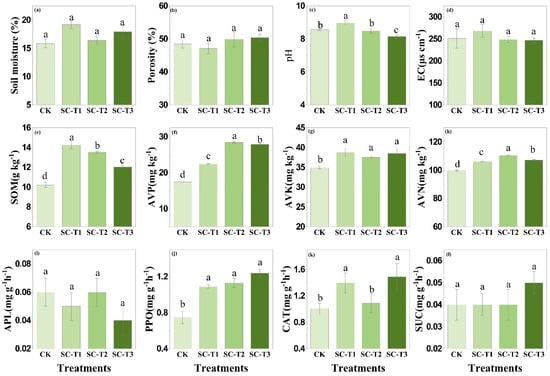
Figure 5.
Physical and chemical properties of Saline-Alkali soil. Lowercase letters indicate whether the samples of the same index are significantly different from each other (p < 0.05). (a) Soil moisture content of saline alkali soil with different treatments; (b) Soil porosity of saline alkali soil with different treatments; (c) Soil pH of saline alkali soil with different treatments; (d) Electrical conductance(EC) of saline alkali soil with different treatments; (e) Soil organic matter of saline alkali soil with different treatments; (f) Available phosphorus (AVP) of saline alkali soil with different treatments; (g) Available potassium (AVK) of saline alkali soil with different treatments; (h) Alkaline hydrolyzable nitrogen (AVN) of saline alkali soil with different treatments; (i) Alkaline phosphatase (ALP) activity of saline alkali soil with different treatments; (j) Polyphenol oxidase (PPO) of saline alkali soil with different treatments; (k) Catalase (CAT) activity of saline alkali soil with different treatments; (l) Sucrase (SUC) activity of saline alkali soil with different treatments.
Compared with the control, the application of vermicompost combined with soil conditioner not only improved the physical and chemical properties of soil in Saline-Alkali soil, but also increased the activity of soil enzymes, in which the activities of catalase and polyphenol oxidase reached a significant difference level (p < 0.05). Compared with the control, the activity of polyphenol oxidase in SC-T1, SC-T2, and SC-T3 soil was increased by 45.33%, 50.67%, and 65.33%, respectively, and the activity of polyphenol oxidase increased with the gradient increase of vermicompost application rate (Figure 5j).
The membership function formula was used to calculate the membership values of the soil water content, porosity, organic matter, available phosphorus, available potassium, alkali-hydrolyzed nitrogen, alkaline phosphatase, polyphenol oxidase, catalase, and sucrase in different saline soils. The membership values of the pH and conductivity were calculated using the inverse membership function (Figure 6). The larger the comprehensive evaluation value, the better the improvement of vegetation indexes, and the comprehensive scores of different treatments were all greater than the control, among which SC-T3 scored the highest, with 8.12.
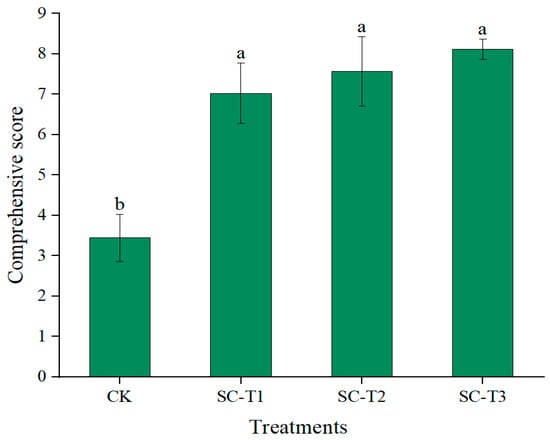
Figure 6.
Comprehensive evaluation of soil. Lowercase letters indicate whether the samples of the same index are significantly different from each other (p < 0.05).
3.3. Soil Microbial Community Diversity
The mixed vermicompost soil conditioner soil amendments improved the Chao1 index in all of the treatments compared with the control, with the SC-T2 amendment showing the most significant improvement. The changes in Simpson and Shannon indices were consistent across the treatments, with significant increases in both indices in the SC-T2 and SC-T3 treatments (Figure 7).
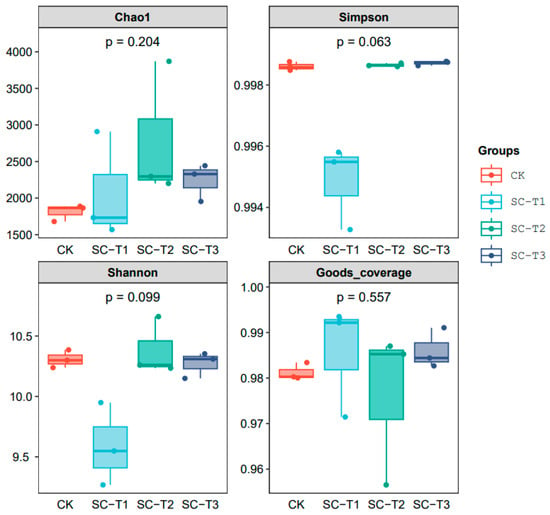
Figure 7.
Alpha diversity of the soil microorganisms.
Membership values of Chao1, Shannon, Simpson, and Goods_coverage of the α diversity index of soil microorganisms in Saline-Alkali soils under different treatments were calculated (Figure 8). The higher the comprehensive evaluation value, the higher the soil microbial activity, the SC-T3 showed the highest score (2.84).

Figure 8.
Comprehensive score of soil microbial activity. Lowercase letters indicate whether the samples of the same index are significantly different from each other (p < 0.05).
3.4. Material Composition of Soil Microorganisms at the Phylum Level
At the phylum classification level, microbial 16S rDNA gene sequencing identified a total of 37 bacterial phyla in the samples. Of these, 20 major phyla with an average abundance of 0.05% or more were detected (Figure 9). The bacterial communities in the Saline-Alkali soil under different treatments exhibited significant differences in frequency distribution. Firstly, Proteobacteria was the dominant bacterial group, with a relative abundance ranging from 26.69% to 33.70% in different treatments. The relative abundance of Proteobacteria in the SC-T3 treatment was the highest, reaching 33.70%, followed by Actinobacteria, Chloroflexi, Acidobacteria, Gemmatimonadetes, Bacteroidetes, Firmicutes, Rokubacteria, and Cyanobacteria. Secondly, in the 20 main phyla, the abundance of SC-T1, SC-T2, and SC-T3 was higher than that of the control. This indicates that the application of the vermicompost and soil conditioner blend is beneficial in the formation of dominant populations in soil microbial communities and creates a unique microbial community in Saline-Alkali soil.
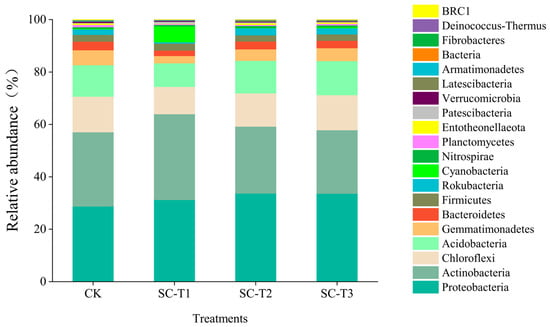
Figure 9.
Distribution statistics of soil microorganisms at the phylum level (top 20 phyla).
3.5. Redundancy Analysis between Environmental Factors and Microbial Community Characteristics
RDA (redundancy analysis) revealed the relationships between soil microbial communities and environmental factors. Figure 10 shows the impact of soil environmental factors on soil microbial phylum-level communities in response to the application of soil amendments. Key soil environmental factors driving the microbial community composition include soil moisture content (MC), porosity, EC, SOM, AP, AK, and AN. Soil pH and SOM are important factors affecting microbial community changes (Figure 10). These factors are in three quadrants, and their correlation with each other is not strong (Figure 10). The first and second principal components explain 82.56% and 6.98% of the variance, respectively.
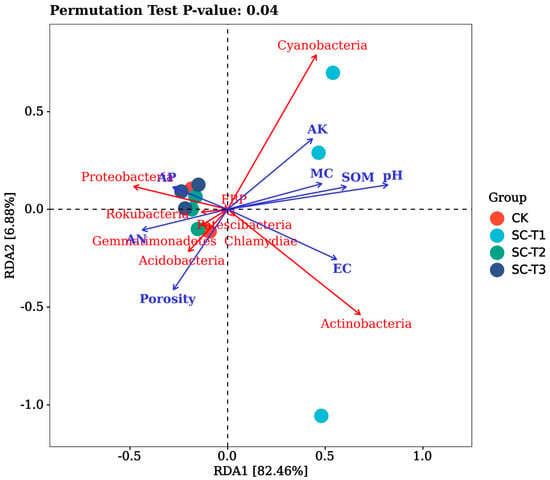
Figure 10.
Redundancy analysis of horizontal microbial species and environmental factors. The blue arrows in the figure represent the dominant environmental factors. The length of the arrow connecting them indicates the strength of the correlation between the environmental factor and soil microorganisms.
3.6. Correlation Analysis between Soil Microbial Population and Physicochemical Properties and Enzyme Activity of Soil
Figure 11 shows the impact of soil environmental factors and the plant enzyme activity on the soil microbial community at the phylum level. The results indicate that the abundance of the dominant phylum Proteobacteria had a significant positive correlation with soil MC, pH, and SOM, as well as a significant negative correlation with AN. Actinobacteria abundance was significantly negatively correlated with AN and had a significant positive correlation with AP. Gemmatimonadetes abundance was closely negatively correlated with SOM and positively correlated with AN. Rokubacteria, on the other hand, was extremely and negatively correlated with pH and positively correlated with AP. Cyanobacteria were closely negatively correlated with soil porosity and positively correlated with pH, whereas Planctomycetes was significantly and negatively correlated with SOM and positively correlated with AN. Entotheonellaeota was extremely highly positively correlated with soil porosity and negatively correlated with pH. The abundance of Patescibacteria was positively correlated with SOM and negatively correlated with AN, whereas that of FinalVerrucomicrobia as extremely negatively correlated with AP, and Latescibacteria abundance was positively correlated with soil porosity.
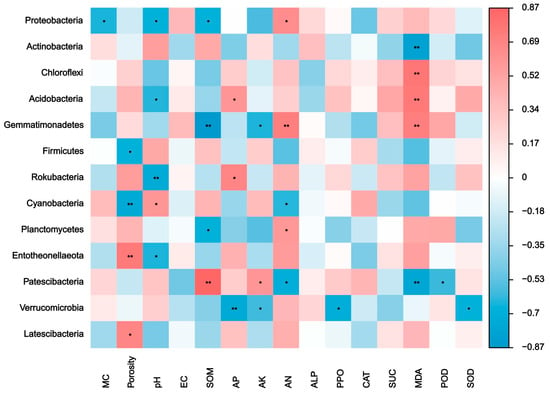
Figure 11.
Correlation analysis between microbial phylum-level species abundance and both soil physicochemical properties and enzyme activities. * and ** indicate the significance level of p < 0.05 and p < 0.01, respectively.
4. Discussion
Saline-Alkali land is a valuable reserve of arable land in China. Improving such land is essential to ensure food security, maintain the stability of existing arable land, and adhere to the bottom line of basic self-sufficiency in grain production [37]. An excessive salt content can cause soil surface compaction, poor soil permeability, and severely affect the growth and development of vegetation, leading to low seedling densities and directly reducing crop yield [38].
Previous studies have reported that vermicompost can improve soil porosity, air permeability, and drainage in degraded soil. Soil amendments can improve soil structure, reduce soil salinity hazards, regulate soil acidity and alkalinity, and increase the soil water content [39,40]. Many experiments have been conducted to improve degraded soil using vermicompost and other soil amendments, which are environmentally friendly types of organic fertilizer that can form a specific ecological niche with soil and vegetation, ultimately improving the agronomic parameters of both [41,42]. In Saline-Alkali soil, organic matter is unstable and easily decomposed, which results in organic matter deficiencies. Vermicompost and soil amendments can directly increase the organic matter levels in Saline-Alkali soil by replenishing it with abundant organic materials [43,44]. Jia et al. [45] discovered that vermicompost amendment can increase crop biomass accumulation and heavy metal transport and bioaccumulation in alfalfa, effectively improving the soil remediation efficiency. Deng et al. [46] found, through laboratory and field experiments, that vermicompost-based amendments can significantly reduce the pH of Saline-Alkali soil and increase the SOM and available nutrients, findings that are consistent with the results of the current study. This may be because organic soil amendments can regulate nitrate flux in soil by reducing gaseous nitrogen loss and reducing nitrogen leaching, and hence improving soil fertility [47]. Earlier research showed that applying vermicompost and soil conditioner to Saline-Alkali soil can impact on the abundance and composition of the microbial community, dissolve and release nutrients in the soil through the soil–plant–microbe interaction, and improve soil quality [48]. Xie et al. [49] found that using organic fertilizer, compounded with soil conditioner, could effectively increase the concentrations of AK and AN in soil, with the concentration of AK increasing four-fold and that of AN doubling, compared with the control. Although the concentrations of AK and AN in soil increased after applying vermicompost-based amendments in the current study, the effect was statistically non-significant, which may be related to the low survival rate of microorganisms in vermicompost under field conditions. The soil enzyme activity is affected by soil physicochemical properties, and the soil sucrase activity is significantly positively correlated with the soil porosity and AP content, and the polyphenol oxidase activity with AK. Therefore, the sucrase and polyphenol oxidase activities in vermicompost-amended soils are higher than in the control, non-amended soil. Furthermore, applying vermicompost-based amendments can significantly increase the height and biomass yield of L. chinensis and enhance crop tolerance to oxidative stress, resulting in an increased yield and crop quality [50]. These effects may be related to the high nutrient concentrations in vermicompost and the excellent physical properties of the soil conditioner. Zeng et al. [51] and others have shown that the anti-stress (antioxidant) enzyme activities in tobacco were significantly improved by the application of organic fertilizer, a finding partly consistent with the results of the present study. Taken as a whole, vermicompost combined with soil amendments can effectively improve the soil physical and chemical indicators and plant physiological and biochemical indicators, so as to achieve the goal of repairing alkali soil.
Soil provides a micro-environment for the growth and reproduction of microbial communities, and soil microorganisms participate in the nutrient cycles of carbon and nitrogen, and in the formation of humus and soil structure. Many studies have shown that organic fertilizers can increase the diversity of soil microbial communities more than chemical fertilizers [52]. However, studies on organic fertilizer compounded with soil conditioner are limited. The present study used high-throughput sequencing to analyze the soil microbial community structure and diversity of soil treated with vermicompost-based amendments, and found that the three dominant microbial populations were similar to those reported by Jin et al. and Yu et al., with the dominant phyla being microbes that existed in most soils, namely actinomycetes, deformable rod bacteria, and acid rod bacteria [53,54]. At the same time, the current study found that the microbial coverage of the 20 major bacterial phyla in treatments SC-T1, SC-T2, and SC-T3 was significantly higher than that of the control, indicating that applying vermicompost-based amendments is beneficial to increasing microbial coverage in Saline-Alkali soil. This may be because the soil microbial community is a relatively stable system, and the effect of applying organic fertilizer is more obvious [55].
Vermicomposting contains a large number of beneficial microorganisms, which can promote the decomposition of organic matter and mineralization of nutrients in soil conditioner, especially the content of available phosphorus [56]. Our research shows that vermicomposting can enhance the richness of some specific phyla, such as Acidobacteria, Firmicutes, and Proteobacteria. Acidobacteria plays an important role in the nitrogen cycle of earthworm fertilizer soil conditioner nutrient system, and can produce polyketide synthase and nonribosomal peptide synthase. These enzymes can catalyze the synthesis of the iron carrier in the soil conditioner, so as to improve soil nutrients and promote plant growth. Firmicutes is considered to be a major co trophic microbiota, which plays an important role in the degradation of soil conditioner fertilizer and increases the utilization efficiency of soil nutrient system. Proteobacteria can participate in the nutrient decomposition process of soil conditioner, and activate the fixed nutrients in soil conditioner to a free state [57]. Although some nutrients of soil conditioner are higher than that of earthworm fertilizer, its’ microbial species and quantity are lower than that of earthworm fertilizer. The appropriate proportion of earthworm fertilizer combined with soil conditioner combines the advantages of both, which can accelerate the decomposition rate of organic matter in Saline-Alkali soil, increase the amount of humus in Saline-Alkali soil, promote the formation of soil aggregate structure, and then fertilize the soil.
Soil microbial communities are highly sensitive to changes in the soil environment. Alterations in soil physicochemical properties lead to changes in the structure of soil microbial communities, which subsequently affect crops [58]. RDA indicated that soil pH and SOM had an important impact on the microbial community composition at the phylum level, and hence were key environmental drivers, a finding consistent with that of Zhao et al. [59]. This is because microorganisms are sensitive to changes in soil pH, so that increases in SOM and decreases in pH caused by vermicompost-based amendments can lead to changes in soil microbial diversity and community composition [60,61]. Actinobacteria and Proteobacteria are bacterial phyla that require high soil nutrient concentrations. Vermicompost-based amendments contain abundant nutrients, providing a good environment for the growth of such bacteria, thereby promoting an increase in their abundance. Proteobacteria are also involved in nutrient recycling, increasing soil fertility and even crop growth. Other studies have suggested a strong positive correlation between SOM and soil microbial community structure, as soil microorganisms use available organic carbon components to promote their physiological metabolism. Therefore, changes in SOM may alter the structure of soil microbial communities [62,63,64]. Taken as a whole, this paper explores the impact on the physical and chemical properties of alkali soil through the combination of vermicompost combined with soil amendments, so as to screen the optimal ratio and provide some technical reference for improving alkali soil.
The current field-based study found links between soil properties, enzyme activity, and microbial populations. Soil properties can clearly affect microbial communities via complex mechanisms, further affect plant biochemical indicators, and the RDA and heatmap analysis showed that the soil pH was highly correlated with Actinobacteria and Actinobacteria was significantly negatively correlated with MDA. Improving soil pH in Saline-Alkali soil can enhance the richness of Actinobacteria, thus inhibiting the impact of harmful microorganisms in Saline-Alkali soil on plants, while MDA will be significantly reduced. The incorporation of vermicompost-based amendments had a major impact on the soil and plant properties. Further studies are necessary to understand these relationships and their mechanisms, including exploring dominant bacterial groups, species combinations, soil characteristics, and vermicompost amendments.
5. Conclusions
Combining vermicompost and solid waste soil conditioner improved the physicochemical properties of Saline-Alkali soil by reducing pH, depending on the treatment, and increasing the SOM and available nutrients. It also improved the activity of soil polyphenol oxidase and peroxidase. Amendments significantly improved the ecological parameters, plant peroxidase, and superoxide dismutase activities, as well as the leaf area, stem thickness, and oxidative stress tolerance. The physiological and biochemical indicators of L. chinensis were also improved in response to soil amendments, with the most significant improvement observed when 30,000 kg·ha−1 of soil conditioner and 15,000 kg·ha−1 of vermicompost were applied together.
The microbial diversity of Saline-Alkali soil also improved after amendments were applied, with the greatest responses being those of soil pH and SOM. Reducing soil pH is one of the basic methods to improve Saline-Alkali land, which can significantly improve plant stress resistance index and achieve the purpose of improving Saline-Alkali land.
Author Contributions
Conceptualization, Q.L.; methodology, L.H. and B.L.; formal analysis, H.Y.; investigation, K.Z.; data curation, C.Z.; writing—original draft preparation, F.A.; writing—review and editing, F.A. and Q.L.; funding acquisition, Q.L. All authors have read and agreed to the published version of the manuscript.
Funding
Financial assistance for this study was provided by the projects of the National Natural Science Foundation of China (Grant Nos. 42207412, 42267071, 41907059), National Key Research and Development Program of China (2022YFF1300802), Postgraduate Innovation Fund of Yulin University.
Data Availability Statement
The data supporting the findings of this study are available from the corresponding author upon reasonable request.
Conflicts of Interest
The authors declare that they have no known competing financial interests or personal relationships that could have appeared to influence the work reported in this paper.
References
- Dong, S.W.; Ma, S.H.; Chu, M. Changes in the microstructure of saline alkali soil under the action of fly ash based soil conditioners. J. Process Eng. 2022, 22, 357–365. [Google Scholar]
- Hu, Y.; Han, J.C.; Zhang, Y. Summary of Research on Saline Alkali Land Improvement Technology. Shaanxi Agric. Sci. 2015, 61, 67–71. [Google Scholar]
- Rath, K.M.; Fierer, N.; Murphy, D.V. Linking bacterial community composition to soil salinity along environmental gradients. ISME J. 2019, 13, 836–846. [Google Scholar] [CrossRef]
- Capula, R.R.; Valdez, L.A.; Cartmill, D.L. Supplementary calcium and potassium improve the response of tomato (Solanum lycopersicum L.) to simultaneousalkalinity, salinity and boronstress. Commun. Soil Sci. Plant Anal. 2016, 47, 505–511. [Google Scholar]
- Hasegawa, P.M. Sodium (Na+) homeostasis and salt tolerance of plants. Environ. Exp. Bot. 2013, 92, 19–31. [Google Scholar] [CrossRef]
- Khan, A.; Khan, A.L.; Muneer, S.; Kim, Y.H.; Al-Rawahi, A.; Al-Harrasi, A. Silicon and salinity: Crosstalk in crop-mediated stress tolerance mechanisms. Front. Plant Sci. 2019, 10, 1429. [Google Scholar] [CrossRef] [PubMed]
- Pan, J.; Wang, L.Y.; Xiao, H. Dynamic changes in soil nutrients of different salt tolerant herbaceous plants in coastal saline alkali land. Chin. J. Agric. 2015, 31, 168–172. [Google Scholar]
- Zhang, P. Effect of Biochar on Phosphorus Adsorption Characteristics and Wheat Growth; Nanjing Information Engineering University: Nanjing, China, 2017. [Google Scholar]
- Xu, X.N.; Chen, K.; Feng, X.J. Study on the advantages of biochar in improving peanut dry matter and nutrient utilization. J. Plant Nutr. Fertil. 2018, 24, 444–453. [Google Scholar]
- Song, Y.L.; Yu, J.; Chen, S.G. Effects of composite microbial agents on the physiological characteristics of cotton and the microbial and chemical properties of rhizosphere soil. Soils 2019, 51, 477–487. [Google Scholar]
- Li, Q.; Ai, F.; Wang, X.; Ma, Y.B.; Liu, L.; Zhu, Z.R.; Zhang, K.Y. Theoretical analysis and practical exploration of soil ecological restoration in coal based solid waste collaborative mining: A case study of Yulin City, Shaanxi Province. Northwest Geol. 2023, 56, 70–77. [Google Scholar]
- Yang, X.L.; Gao, W.; Peng, Y.B. The effect of earthworm bio organic fertilizer on the growth and quality of Chinese cabbage. Heilongjiang Agric. Sci. 2021, 8, 34–37. [Google Scholar]
- Xu, Y.Q.; Yan, H.T.; Wang, X.Q. The effect of biochar combined with organic fertilizer on microbial functional diversity in brown soil tobacco fields. China Tob. Sci. 2020, 41, 55–59+67. [Google Scholar]
- Yuan, J.X.; Li, X.P.; Wu, F.D. The effect of earthworm manure organic fertilizer on the physicochemical properties of vineyard soil. Anhui Agric. Sci. 2023, 51, 169–171+191. [Google Scholar]
- Stavridou, E.; Giannakis, I.; Karamichali, I. Biosolid-Amended Soil Enhances Defense Responses in Tomato Based on Metagenomic Profile and Expression of Pathogenesis-Related Genes. Plants 2021, 10, 2789. [Google Scholar] [CrossRef]
- Lu, J.N.; Zhang, Q.; Liu, T.J. The effects of different amendments on the growth of Kentucky bluegrass in saline alkali soil and grassland. Grassl. Sci. 2017, 34, 1141–1148. [Google Scholar]
- Lai, C.G.; Chen, Z.; Xie, M.J. The effects of soil conditioners on soil environment and crop yield. Phosphate Compd. Fertil. 2018, 33, 23–25+46. [Google Scholar]
- Xiao, X.Y.; Li, X.; Shi, F.H. Exploration of saline alkali land management plans in the northwest region. Agric. Technol. 2021, 41, 142–145. [Google Scholar]
- Bai, M.; Yao, Y.; Wang, J. Effects of Waste Residue of Chinese Herbs on Soil Physical-Chemical Properties and Microbial Quantities and Enzyme Activities of Abandoned Salkaline Land in Arid Area. Bull Soil Water Conserv. 2014, 6, 13–17. [Google Scholar]
- GB15618-2018; Soil Environmental Quality, Agricultural Land Soil Pollution Risk Management And Control Standard. China Standards Press: Beijing, China, 2018.
- Matin, G.; Kayıkçıoğlu, H.H. Effect of vermicompost and biochar application on microbial activity of soil under deficit irrigation. J. Glob. Clim. Change 2022, 1, 51–61. [Google Scholar] [CrossRef]
- Walkley, A. A critical examination of a rapid method for determining organic carbon in soils—Effect of variations in digestion conditions and of inorganic soilconstituents. Soil Sci. 1947, 63, 251–264. [Google Scholar] [CrossRef]
- Guo, Y.F. Discussion and correlation study on the determination of soil available potassium using ammonium acetate flame photometry and M3 method. Shanxi Sci. Technol. 2014, 29, 54–56. [Google Scholar]
- Li, J. Study on the Determination of Effective Phosphorus in Soil by Sodium Bicarbonate Extraction. Resour. Conserv. Environ. Prot. 2019, 10, 105. [Google Scholar]
- Hou, J.W.; Xing, C.F.; Yang, L.L. Optimization and Reform of Soil Alkaline Hydrolyzed Nitrogen Determination Method. J. Southwest Norm. Univ. (Nat. Sci. Ed.) 2021, 46, 45–49. [Google Scholar]
- Zhou, H.; Geng, Y.; Cong, R.; Li, Y.; Liu, D. Effects of Wood Vinegar on Chemical Properties, Enzyme Activities and Their Correlation in Saline Alkali Soil. Chin. J. Soil Sci. 2016, 1, 105–111. [Google Scholar]
- Di, H.; Zhou, C.; Zeng, X.; Wang, S.; Wang, Y.; Wang, Z. Effect of genetically modified salt-tolerant maize with gene BADH(Zeamays L.) on soil enzymes activity. Northeast. Agric. Univ. 2014, 4, 25–29. [Google Scholar]
- Shi, C.F.; Wang, Z.Y.; Leng, X.Y.; Liu, J.M.; Cao, J.M. Improvement of soil phosphatase activity measurement method. Exp. Technol. Manag. 2016, 33, 48–49+54. [Google Scholar]
- Wang, Z.; Yang, Y.; Xia, Y. Time-course relationship between environmental factors and microbial diversity in tobacco soil. Sci. Rep. 2019, 9, 19969. [Google Scholar] [CrossRef] [PubMed]
- Yang, F.; Cen, R.; Feng, W.; Liu, J.; Qu, Z.; Miao, Q. Effects of Super-Absorbent Polymer on Soil Remediation and Crop Growth in Arid and Semi-Arid Areas. Sustainability 2020, 12, 7825. [Google Scholar] [CrossRef]
- Fu, W.; Ma, X.J.; Jia, H.T. Effects of Na+ on the Growth and superoxide Dismutase of Non-salt Plant Wheat Seedlings. Anhui Agric. Sci. 2010, 38, 9446–9447+9493. [Google Scholar]
- Liu, H.Y.; Jing, P.; Wang, M. Improvement of experimental teaching of determining peroxidase activity in plant. Exp. Technol. Manag. 2012, 29, 136–137+145. [Google Scholar]
- Li, Z.F.; Wu, X.D. Experimental Design Scheme for the Effect of Drought Stress on Content of Malondialdehyde of lndoor Ornamental Plants. Tianjin Agric. Sci. 2016, 22, 49–51. [Google Scholar]
- Wang, Q.; Wang, C.; Yu, W. Effects of nitrogen and phosphorus inputs on soil bacterial abundance, diversity and community composition in Chinese fir plantations. Front. Microbiol. 2018, 9, 1543. [Google Scholar] [CrossRef] [PubMed]
- McMurdie, P.J.; Holmes, S. Phyloseq: An R package for reproducible interactive analysis and graphics of microbiome census data. PLoS ONE 2013, 22, 8. [Google Scholar] [CrossRef] [PubMed]
- Song, X. Effects of Different Organic Substrates on the Growthyield and Ouality of Lettuce; Northwest A & F University: Xieyang, China, 2013. [Google Scholar]
- Liu, M.; Wang, Z.C.; Yang, F. Progress in the application of biochar in saline alkali land improvement. J. Soil Water Conserv. 2021, 35, 1–8. [Google Scholar]
- Yan, H.; Zhong, S.Z.; Wen, X.L. The effects of different modifiers on the agronomic traits and yield of sunflowers in saline alkali soil. J. North. Agric. 2021, 49, 36–40. [Google Scholar]
- Wang, D. Study on the Effect of Composite Soil Conditioner on the Treatment of Saline Alkali Soil in Hetao Irrigation District, Inner Mongolia; Inner Mongolia Agricultural University: Hohhot, China, 2020. [Google Scholar]
- Li, T.F.; Wang, A.J.; Li, H. Effect of earthworm dung on microenvironment of rhizosphere soil for pepper growth and yield benefit analysis. Anhui Agric. Sci. 2022, 50, 147–149. [Google Scholar]
- Kavitha, B.; Reddy, P.V.; Kim, B. Benefits and limitations of biochar amendment in agricultural soils: A review. J. Environ. Manag. 2018, 227, 146–154. [Google Scholar] [CrossRef]
- Mupambwa, H.A.; Mnkeni, P.N. Optimizing the vermicomposting of organic wastes amended with inorganic materials for production of nutrient-rich organic fertilizers: A review. Environ. Sci. Pollut. Res. 2018, 25, 10577−10595. [Google Scholar] [CrossRef] [PubMed]
- Ai, F.; Li, Q.; Ren, H.D. Effects of earthworm fertilizer combined with soil conditioner on soil properties and the growth of Leymus chinensis in Maowusu sandy land. Shaanxi Agric. Sci. 2022, 68, 11–17. [Google Scholar]
- Manuel, B.; Julien, B.; Nicolas, M. Vermicompost significantly affects plant growth. A meta-analysis. Agron. Sustain. Dev. 2019, 39, 2−15. [Google Scholar]
- Jia, Y.M.; Liu, W.; Wang, Q. The effect of earthworm fertilizer on the growth and heavy metal accumulation of alfalfa in copper and zinc contaminated soil. J. Shanxi Agric. Univ. (Nat. Sci. Ed.) 2021, 41, 121–128. [Google Scholar]
- Deng, P.B.; Guo, L.P.; Yang, H.T.; Leng, X.Y.; Wang, Y.M.; Bi, J.; Shi, C.-F. Effect of an Organic Fertilizer of Ganoderma lucidumResidue on the Physical and Chemical Properties and Microbial Communities of Saline Alkaline Soil. Water 2023, 15, 962. [Google Scholar] [CrossRef]
- Li, Q.; Wang, Y.H.; Li, Y.C. The effects of different types of conditioners on the remediation effect and microbial community of cadmium contaminated soil. South. Agric. J. 2022, 53, 1855–1866. [Google Scholar]
- Lu, H.J.; Zhou, D.L.; Ye, W.L. Research progress of bio organic fertilizers in soil improvement and heavy metal pollution remediation. Environ. Pollut. Prev. 2019, 41, 1378–1383. [Google Scholar]
- Xie, X.H.; Li, Y. Effects of Agaricus blazei fungus bran on soil chemistry and forage growth in soda saline alkali soil. J. Jilin Agric. Univ. 2010, 32, 518–522. [Google Scholar]
- Ge, J.Q.; Yu, X.C.; Wang, Z.H. Microbial fertilizer effect and its application prospects. Chin. J. Ecol. Agric. 2003, 3, 93–94. [Google Scholar]
- Zeng, Q.B.; Li, T.; Gou, X.M. The effect of adding Trichoderma fertilizer to the seedbed on the growth and stress resistance enzyme activity of two types of tobacco seedlings. J. Sichuan Agric. Univ. 2019, 37, 28–33. [Google Scholar]
- Wang, L.L.; Dong, M.; Zhang, L.; Du, X.G. The effect of different carbon to nitrogen ratios of organic fertilizers on soil microbial biomass in organic agriculture. Chin. J. Ecol. Agric. 2013, 21, 1073–1077. [Google Scholar] [CrossRef]
- Yu, H.L. Study on the Effect of Nitrogen Application Rate on the Characteristics of Soil Microbial Community Composition; Jilin Agricultural University: Jilin, China, 2017. [Google Scholar]
- Jin, Q. Study on Characteristics of Soil Microbial Community in Typical Wetlands of Poyang Lake and Its Response to Environmental Change; Jiangxi Normal University: Jiangxi, China, 2017. [Google Scholar]
- Wu, P.P.; Yang, S.F.; Liu, S.W. The effect of carbon based soil conditioner combined with specialized fertilizer on soil microorganisms and enzyme activity in maize. Chin. J. Agron. 2021, 37, 66–73. [Google Scholar]
- Xu, Z.N.; Wang, C.; Zhu, C. Effects of vermicompost and soil proportion on the microbial property of substrate and the growth and quality of leek. J. Plant Nutr. Fertil. 2019, 25, 519–524. [Google Scholar]
- Wang, B.L.; Wang, C.; Liu, M.L. Ecological remediation of earthworms on soil-plant system: A review. Chin. J. Appl. Ecol. 2021, 32, 2259–2266. [Google Scholar]
- Ghosh, A.; Bhattacharyya, R.; Dwivedi, B.S. Temperature sensitivity of soil organic carbon decomposition as affected by long-term fertilization under a soybean based cropping system in a sub-tropical Alfisol. Agric. Ecosyst. Environ. 2016, 233, 202–213. [Google Scholar] [CrossRef]
- Abee, T.; Groot, M.N.; Tempelaars, M. Germination and outgrowth of spores of Bacillus cereus group members: Diversity and role of germinant receptors. Food Microbiol. 2011, 28, 199–208. [Google Scholar] [CrossRef] [PubMed]
- Rousk, J.; Brookes, P.C.; Baath, E. Investigating the mechanisms for the opposing pH relationships offungal and bacterial growth in soil. Soil Biol. Biochem. 2010, 42, 926–934. [Google Scholar] [CrossRef]
- Zhao, H.B.; Zheng, W.L.; Zhang, S.W.; Gao, W.L.; Fan, Y.Y. Soil microbial community variation with time and soil depth in Eurasian Steppe (Inner Mongolia, China). Ann. Microbiol. 2021, 71, 21. [Google Scholar] [CrossRef]
- Cui, H.; Sun, W. The effects of mowing and multi-level N fertilization on soil bacterial and fungal communities in a semiarid grassland are year- dependent. Soil Biol. Biochem. 2020, 151, 108040. [Google Scholar] [CrossRef]
- Wang, X.; Zhang, W.; Liu, Y. Identification of microbial strategies for labile substrate utilization at phylogenetic classification using a microcosm approach. Soil Biol. Biochem. 2021, 153, 107970. [Google Scholar]
- Sha, M.; Xu, J.; Zheng, Z. Enhanced atmospheric nitrogen deposition triggered little change in soil microbial diversity and structure in a desert ecosystem. Glob. Ecol. Conserv. 2021, 31, 01879. [Google Scholar] [CrossRef]
Disclaimer/Publisher’s Note: The statements, opinions and data contained in all publications are solely those of the individual author(s) and contributor(s) and not of MDPI and/or the editor(s). MDPI and/or the editor(s) disclaim responsibility for any injury to people or property resulting from any ideas, methods, instructions or products referred to in the content. |
© 2023 by the authors. Licensee MDPI, Basel, Switzerland. This article is an open access article distributed under the terms and conditions of the Creative Commons Attribution (CC BY) license (https://creativecommons.org/licenses/by/4.0/).